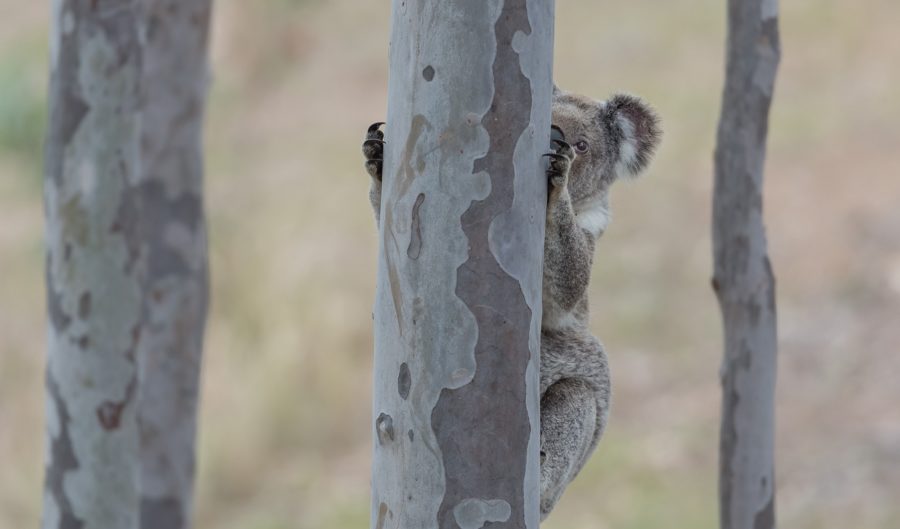Koalas are feeling the heat, and we need to make some tough choices to save our furry friends

Koalas are a much-loved Australian icon and a tourism moneyspinner too, contributing more than A$1 billion each year to Australia’s economy.
Worryingly, however, there is growing evidence that koala populations are declining rapidly in many parts of Australia. They are thought to be declining in all but one bioregion (a way of classifying ecosystems) in Queensland and New South Wales.
They also face the growing threat of climate change. Recent modelling found that koala habitat could be considerably reduced as the world warms, particularly due to heatwaves and rainfall.
These declines are deeply concerning and failure to reverse them can result in only one outcome: the loss of koalas from many parts of the Australian landscape. But conserving koalas is a complex job.

A wicked problem
In western Queensland, koala numbers declined by 80 per cent between 1995 and 2009, mainly because of habitat loss, drought and heatwaves.
In southeast Queensland, where threats from urban development are a key factor, some populations fell by 55-80 per cent between 1996 and 2015.
The picture is similar in NSW, where there is evidence for a substantial decline in koala numbers over the two centuries from European settlement in 1788 to the first major statewide survey in 1986-87. Subsequent studies have identified steep declines and local extinctions of koala populations in the past 30 years.
Unfortunately, there may be no quick fix: koala recovery has many of the characteristics of a wicked problem, riddled with dilemmas, trade-offs and tough choices.
For a start, koalas are declining for several complex reasons. In the western parts of Queensland and NSW, the main factors are climate change (drought and heatwaves) and habitat loss. Along the coast, koalas are chiefly threatened by rapid urban development and the associated impact of vehicle collisions and dog attacks.
There is also considerable uncertainty about the role of disease (such as chlamydia and retroviral infections) in driving koala declines. We don’t know whether this is a cause or a symptom of the koalas’ plight, but we know that it is likely to be having an important impact.
These complexities make it difficult to identify the best management strategies to try to improve things.
There are also social and political complexities that tend to polarise, or at least confuse, the debate about koala conservation. For instance, there are strong trade-offs between koala conservation and other human needs and wants, such as land for urban development, agriculture and economic progress. In reality, these trade-offs tend to limit what is possible for koala recovery.
Finding solutions
In our research we are looking at koala recovery strategies that factor in different threats and trade-offs. In a recent study we looked at which recovery strategies to prioritise across NSW.
Interestingly, instead of spreading conservation efforts thinly across the state, we found the best option by far is to concentrate on particular regions.
If funding is low (say, A$2 million each year) we found it better to focus on koalas in eastern parts of NSW and reduce threats from urban development, particularly dog control.
But if funding is higher (say, A$40 million per year) it is possible to spread conservation efforts more easily between eastern and western parts of the state (reducing the impact of urban development in the east, and habitat loss in the west).
The NSW government has pledged A$100 million for threatened species over five years. With only some of this going to koalas, our work indicates that the strategic prioritisation of limited funding is critical (and potentially should favour eastern over western populations).

Planning for koala recovery
Koalas were listed as “vulnerable” in Queensland, NSW and the Australian Capital Territory under national threatened species legislation in 2012. This is helping to limit impacts on koalas from future development.
But true koala recovery will require a concerted effort by all levels of government and the community to implement measures to combat existing threats. In this process, identifying the best strategic actions and locations for action will be vital.
The federal government has begun a koala recovery planning process, drawing on past efforts. However, a review of koala conservation found that while the objectives were basically fine, the implementation was largely missing.
A key issue is that planning is principally a state matter and detailed planning a local government matter embedded within state legislative frameworks. This means that planning for koala survival and recovery must include all levels of government and their legislative and policy frameworks.
Our research shows the importance of strategic investment in koala conservation, rather than a scattergun approach. The challenge is to formulate an integrated strategy across governments that funds the activities that really work, to yield the highest return for the funds invested. This is not a modest challenge, but is essential to provide koalas with the best chance of long-term survival.
Jonathan Rhodes is Associate Professor at The University of Queensland; Clive McAlpine is Senior Research Fellow in Ecology at The University of Queensland; Daniel Lunney is Adjunct Professor of Zoology at the University of Sydney; Kerrie Wilson is Associate Professor and ARC Future Fellow at The University of Queensland, and Truly Santika is a Research Fellow at The University of Queensland.
This article was originally published on The Conversation. Read the original article.


